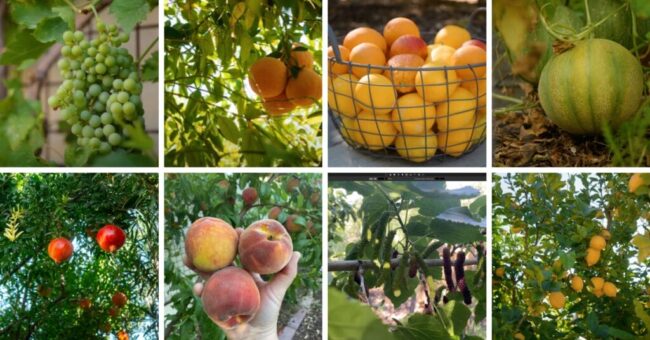

Many types of fruit and fruit trees thrive in the low desert of Arizona and are surprisingly easy to grow with the right variety and care. This Arizona Fruit Planting Guide provides planting dates and essential growing tips for 25 types of fruit that do well in our climate. With the right mix of trees, it’s possible to enjoy fresh fruit from your garden nearly year-round.
The low desert includes areas below 3,500 feet in elevation, such as the Phoenix and Tucson metro regions and other parts of the Southwestern U.S. with similar growing conditions.
When choosing deciduous fruit trees, pay attention to their chill hour requirements—the number of hours between 32°F and 45°F needed to set fruit. In the low desert, select varieties that require 400 chill hours or fewer. All varieties listed in this guide meet that requirement. Keep in mind that warmer winters may reduce chill hours, which can lead to variable fruit production from year to year.
Helpful Resources for Growing Fruit in Arizona’s Low Desert:
If you’re looking to grow fruit successfully in the low desert, these posts will guide you every step of the way:
How to Label Fruit Trees – Never forget what you planted—use these labeling tips to stay organized season after season.
What to Plant for Year-Round Fruit Tree Harvests – Get inspired by a seasonal planting plan so you always have something to harvest.
How and Why to Thin Fruit Trees – Thinning helps ensure healthy fruit and prevents branch breakage—learn when and how to do it.
When and How to Prune Fruit Trees – Timing and technique matter. This post explains the best way to prune for productivity and shape.
How to Create a Permaculture Food Forest – Design a layered, sustainable fruit-growing system that thrives in a desert climate.
Organic Fruit Tree Fertilizing in 4 Simple Steps – Learn the yearly fertilizing schedule and what your fruit trees need to stay healthy.
Planting Bare Root and Container Fruit Trees: A Step-by-Step Guide – Whether you’re planting in winter or spring, follow this guide for a strong start.
Thriving Edible Perennials for the Low Desert – Discover which low-maintenance perennials add beauty and productivity to your garden.
Click on the fruit name to go directly to that fruit:
Apple

How to Grow Apples in Arizona:
Apples can thrive in the low desert if you choose low-chill varieties. With proper pruning and care, they produce crisp, delicious fruit in late spring or early summer.
Varieties of apple trees that grow well in Arizona:
- Anna – Self-fruitful (200 hours)
- Beverly Hills – Self-fruitful (300 hours)
- Ein Shemer – Self-fruitful (100 hours)
- Gordon – Self-fruitful (400 hours)
- Golden Dorsett – Self-fruitful (100 hours)
The best time to plant apple trees in Arizona: Fall or spring when planted from container plants. Bare root trees should be planted in January or early February.
Months to harvest: June through September, depending on variety.
Tips for growing apple trees in Arizona:
- Fertilize and prune before bud break.
- Prune lightly, removing only ⅓ of limbs.
- Thin fruit to 1-2 per bunch after fruit set.
Apricot
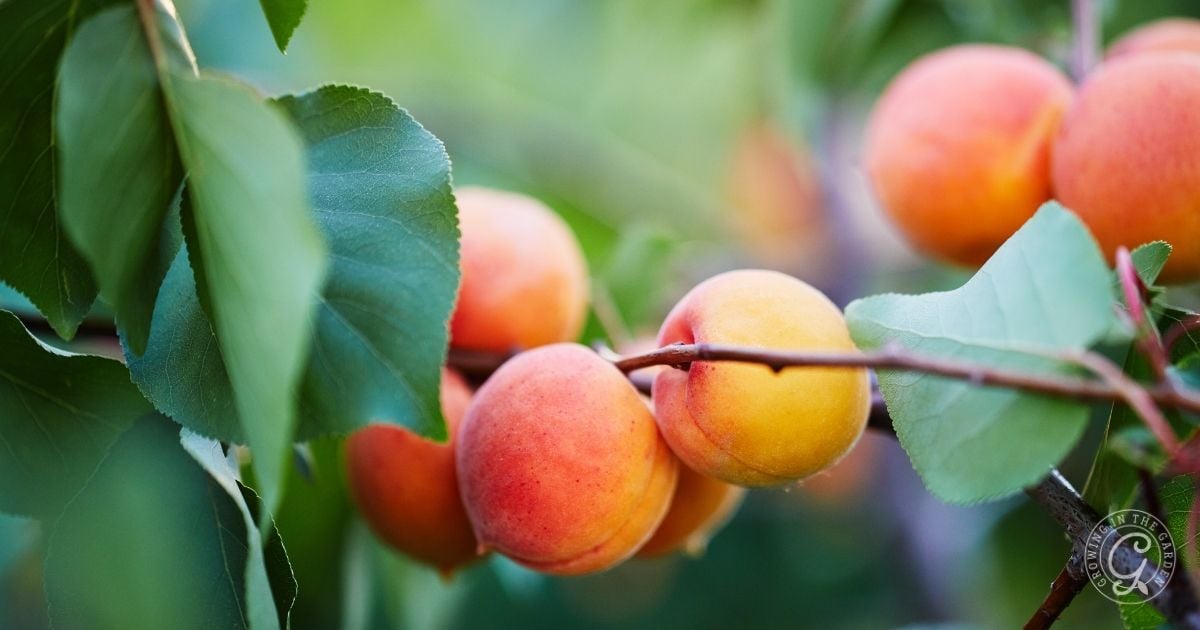
How to Grow Apricots in Arizona:
Apricots are well-adapted to Arizona’s climate and ripen early—often before summer heat hits. Choose low-chill types and protect blossoms from late frosts.
Varieties of apricot trees that grow well in Arizona:
- Gold Kist – self-fruitful (300 hours)
- Katy – self-fruitful (400 hours)
- Modesto – self-fruitful (300-400 hours)
- Blenheim (Royal) – self-fruitful (400 hours)
The best time to plant apricot trees in Arizona: Fall or spring when planted from container plants. Bare-root trees should be planted in January or early February.
Months to harvest: May – June
Tips for growing apricot trees in Arizona:
- Fertilize and prune before bud break.
- Fertilize monthly during the growing season.
- Thin apricots to at least 2 inches apart as soon as possible after fruit set.
Asian Pear

How to Grow Asian Pears in Arizona:
Asian pears combine the crisp texture of apples with the sweetness of pears. They grow well in full sun with minimal disease issues and need thinning for best fruit size.
Varieties of Asian pear trees that grow well in Arizona:
- Shinseiki – self-fruitful (350-400 hours)
- Yakumo – pollinator required (450 hours)
Best time to plant Asian pear trees in Arizona: Fall or spring when planted from container plants. Bare root trees should be planted in January or early February.
Months to harvest: May through June, depending on variety.
Tips for growing Asian pears in Arizona:
- Fertilize and prune before bud break.
- Fertilize monthly during the growing season.
- Thin pears to at least 4 inches apart as soon as possible after fruit set.
Banana
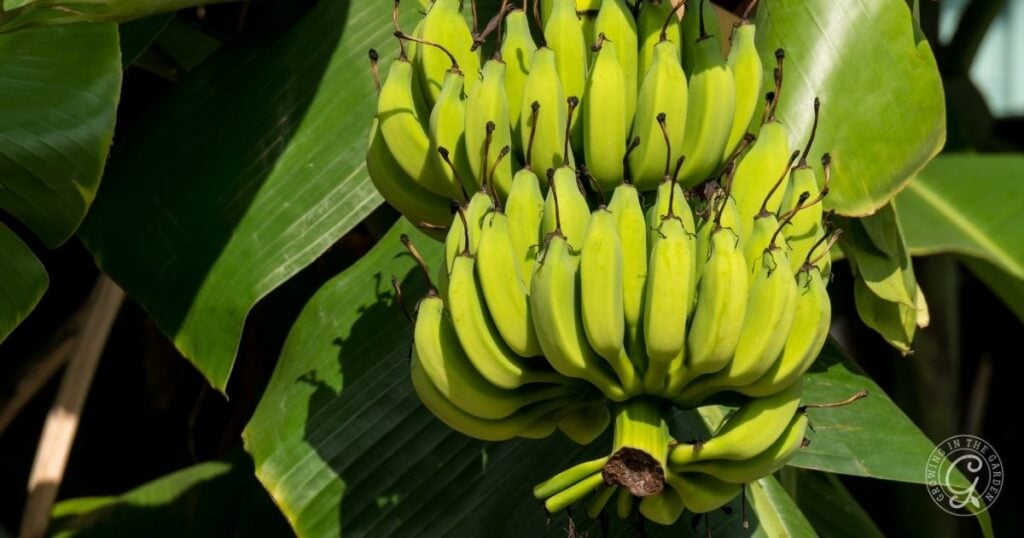
How to Grow Bananas in Arizona:
Bananas can grow in sheltered microclimates in the low desert. They need rich soil, frequent watering, and protection from frost and extreme summer sun.
Varieties that grow well in Arizona:
- Rajapuri, Dwarf Cavendish, Dwarf Orinoco
Best time to plant:
Late spring or early summer, after soil warms
Months to harvest:
12–18 months after planting, depending on conditions
Tips:
- Remove suckers to direct energy to fruiting stalk.
- Best grown in protected courtyards or near block walls for warmth.
- Mulch heavily and water consistently.
Arizona Fruit Planting Guide: A Visual Guide for Low Desert Fruit
Blackberry
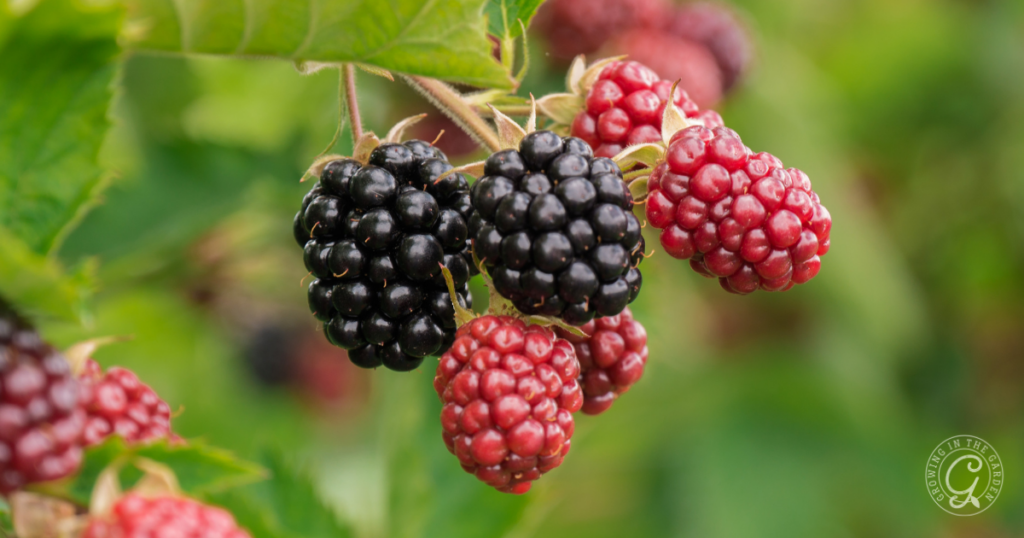
How to Grow Blackberries in Arizona:
Blackberries grow as thornless or thorny canes and produce juicy, sweet fruit in early summer. Plant in rich soil with afternoon shade for best results in Arizona.
Varieties of blackberries that grow well in Arizona:
- Brazos – thorny; large berries; heavy yield
- Rosborogh – large, sweet fruit
Best time to plant blackberry transplants in Arizona: February – March and October
Months to harvest: Begins in early May
Tips for growing blackberries in Arizona:
- Water frequently when young. Once established, water deeply. Water more frequently during dry/hot weather, when flowering, and when fruit is ripening.
- Fertilize in early March and in late July.
- Blackberry canes are biennial. The canes are fruitless the first year, and then bear fruit the second year, and die after fruiting. Remove all fruiting canes in June after harvest.
Cherry (Including Barbados Cherry)
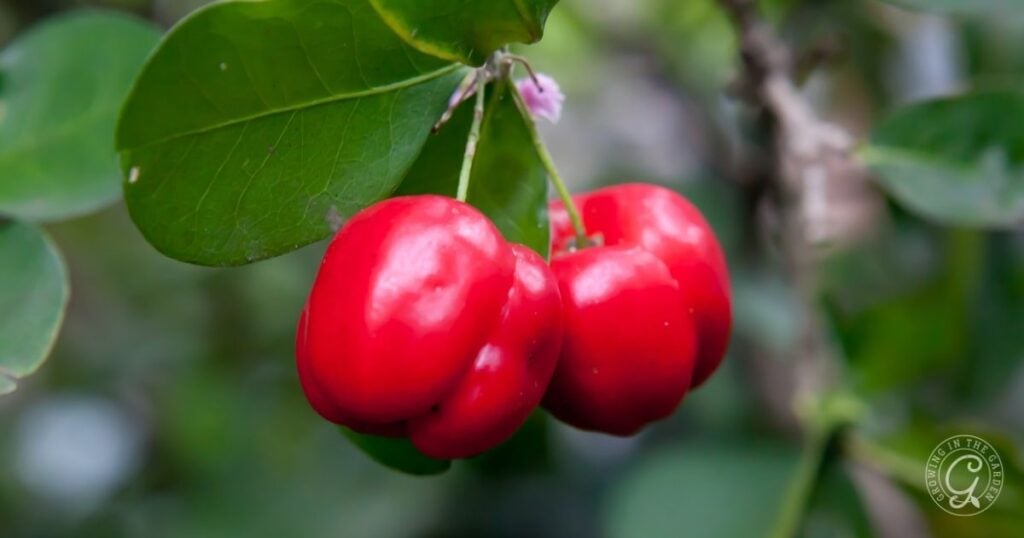
How to Grow Cherries in Arizona:
Traditional cherry trees can be challenging to grow in the low desert due to chill hour requirements and sensitivity to heat, but low-chill varieties like ‘Minnie Royal’ and ‘Royal Lee’ may succeed with care. Barbados cherry, on the other hand, is a tropical, heat-loving shrub that grows well in Arizona and produces small, vitamin C-rich fruit with minimal fuss.
Varieties of cherries that grow well in Arizona:
- Minnie Royal and Royal Lee (require cross-pollination)
- Barbados Cherry – Also called acerola cherry; not a true cherry but a great alternative for desert gardeners
Best time to plant cherries in Arizona:
Late fall through early spring, when temperatures are mild and roots can establish before summer heat.
Months to harvest:
- Traditional cherries: May to early June
- Barbados cherry: Multiple harvests from late spring through fall
Tips for growing cherries in Arizona:
- Traditional cherries require low-chill hours (300–400) and need protection from intense sun and drying winds.
- Plant Minnie Royal and Royal Lee together for cross-pollination.
- Provide afternoon shade and consistent moisture during blooming and fruiting.
- Barbados cherry thrives in full sun, tolerates high heat, and benefits from some frost protection when young.
- Prune Barbados cherry lightly to shape and encourage branching; protect both types from birds when fruiting.
Citrus

How to Grow Citrus in Arizona:
Citrus is a staple in Arizona gardens thanks to its heat tolerance and year-round greenery. Choose varieties based on harvest time to enjoy fruit from fall through spring.
Varieties of citrus that grow well in Arizona: Nearly all varieties do well in the low desert of Arizona. Calamondins and kumquats are the most cold hardy; lemons and limes are the least.
Best time to plant citrus in Arizona: (usually mid to late February). Citrus can be planted from this time through May. Do not plant citrus from June through September. A second planting window for citrus occurs in the fall, from October to December.
Months to harvest: Late fall through early spring depending on variety.
Tips for growing citrus in Arizona:
- Newly-planted citrus is more susceptible to frost and needs frost protection.
- Fertilize mature citrus on Valentine’s Day, Memorial Day, and Labor Day.
- Heavy pruning should be done after danger of frost is passed.
- Paint exposed bark to protect from sun.
Read this article for more information about how to grow citrus in Arizona.
Date

How to Grow Dates in Arizona:
Date palms are perfectly suited for the desert—they love heat and low humidity. You’ll need both a male and female tree for fruit production and plenty of space.
Varieties of dates that grow well in Arizona: Date Palm
Best time to plant date trees in Arizona: Spring and fall
Months to harvest: Summer
Tips for growing dates in Arizona:
- Trees are large, growing to 100 feet tall and wide.
- Get damaged at temperatures below 18°F.
Arizona Fruit Planting Guide: A Visual Guide for Low Desert Fruit
Fig

How to Grow Figs in Arizona:
Figs thrive in Arizona’s hot, dry climate and are nearly foolproof once established. They produce sweet fruit in summer and often again in fall.
Varieties of figs that grow well in Arizona:
- Black Mission – large, long-lived tree
- Brown Turkey – better in higher elevations (2000-3000 feet)
- Conadria – tolerates heat well
- White Kadota – hot weather helps ripen
Best time to plant fig trees in Arizona: Early spring and fall
Months to harvest: May and late fall
Tips for growing fig trees in Arizona:
- Hardy to 10°F.
- Fertilize container trees with aged manure in January.
- Trees grow very large but can be pruned for size or grown in containers.
Read this article for more information about how to grow figs.
Goji Berry

How to Grow Goji Berries in Arizona:
Goji berries are hardy shrubs that tolerate heat and alkaline soil, producing small, nutritious berries. They grow best with full sun and moderate water.
Best time to plant goji berries in Arizona: Spring and fall
Months to harvest: Spring and late fall
Tips for growing goji berries in Arizona:
- Berries form on the current year’s wood.
- Pruning encourages new growth and keeps the plant open for light and air circulation.
- Plants begin producing at 2 years old and reach maximum production after 3-5 years.
Grapes

How to Grow Grapes in Arizona:
Grapes love Arizona sunshine and can be trained on arbors or trellises. Choose varieties that ripen before the monsoon season for best results.
Varieties of grapes that grow well in Arizona:
- Thompson Seedless – classic green grape, thrives in full sun, great for drying into raisins
- Ruby Seedless – red, sweet, and crisp; needs heat to fully develop flavor
- Beauty Seedless – early ripening; good for fresh eating, prefers warm but not extreme heat
- Flame Seedless – vigorous and productive; excellent in hot, dry climates like the low desert
Best time to plant grape transplants in Arizona: February 15 – March and October
Months to harvest: July – August
Tips for growing grapes in Arizona:
- Roots go 2 feet deep; plant in rich soil.
- Water slowly, deeply, and infrequently. During the summer, water every 7 to 10 days.
- Fertilize mature grapes in February and May.
- Learn how to train and prune.
- Look out for Western grape leaf skeletonizer; use Bacillus thuringiensis (Bt.) to control.
Read this article for more information about how to grow grapes.
Ground Cherry

How to Grow Ground Cherries in Arizona:
Ground cherries are small, husk-covered fruits with a tropical flavor. These heat-loving annuals grow easily from seed and make a great addition to summer gardens.
Varieties of ground cherries that grow well in Arizona:
- Aunt Molly’s – sweet, citrus flavor; great for jams and snacking
- New Hanover – tropical taste; larger fruit; loves heat and sun
Plant seeds indoors: December – January and May – June
Plant transplants outdoors: February 15 – March and July 15 – September
Months to harvest: May – July and October – November
Tips for growing ground cherries in Arizona:
- Seeds are slow to germinate. Start seeds indoors 6 – 8 weeks before planting.
- Plants grow large; provide support.
- Ground cherries are ready to harvest when they fall to the ground.
Read this article for more information about how to grow ground cherries.
Arizona Fruit Planting Guide: A Visual Guide for Low Desert Fruits (continued)
Jujube (Chinese Date)

How to Grow Jujubes (Chinese Dates) in Arizona:
Jujubes are incredibly drought- and heat-tolerant trees that produce crisp, apple-like fruit. Once established, they require very little care and thrive in poor soil.
Varieties of jujube (Chinese date) that grow well in Arizona:
- Li – large, round fruit; sweet and crisp fresh
- Lang – best dried; firmer and more tart than Li
- Sherwood – late ripening; flavorful and less prone to cracking
Best time to plant jujube in Arizona: Fall or spring
Months to harvest: Late summer to fall
Tips for growing jujube in Arizona:
- Hardy to -20°F.
- Space trees 15-30 feet apart, depending on variety.
- Deciduous; has thorns.
- Allow fruit to drop for harvest.
- Drought tolerant.
- Does not need additional fertilizer.
- Prune in winter while dormant.
Loquat
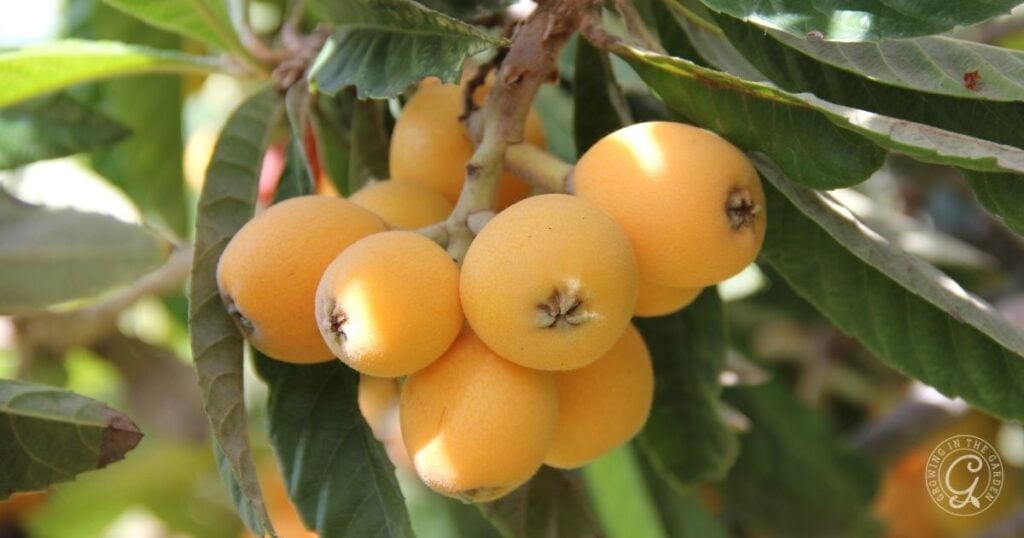
How to Grow Loquats in Arizona:
Loquats are attractive evergreen trees that produce sweet, tangy fruit in early spring. They can grow in Arizona with afternoon shade and frost protection.
Varieties that grow well in Arizona:
- Big Jim, Gold Nugget, Champagne
Best time to plant:
Fall or early spring
Months to harvest:
March to May
Tips:
- May not produce reliably every year in colder microclimates.
- Provide afternoon shade and protect from hard frosts when young.
- Water deeply during fruit development.
Moringa

How to Grow Moringa in Arizona:
Also called the drumstick or miracle tree, moringa thrives in heat and poor soil. It’s grown for its edible leaves, pods, and flowers and makes a great addition to edible landscapes.
Varieties that grow well in Arizona:
- Moringa oleifera is most common and widely adapted
Best Time to plant:
Spring, once soil is warm
Months to harvest:
Leaves and pods can be harvested throughout the warm season
Tips:
- Requires frequent harvesting to keep manageable.
- Fast-growing; can be grown as a tree or pruned into a shrub.
- Very frost-sensitive—regrows from roots after mild freezes.
Mulberry
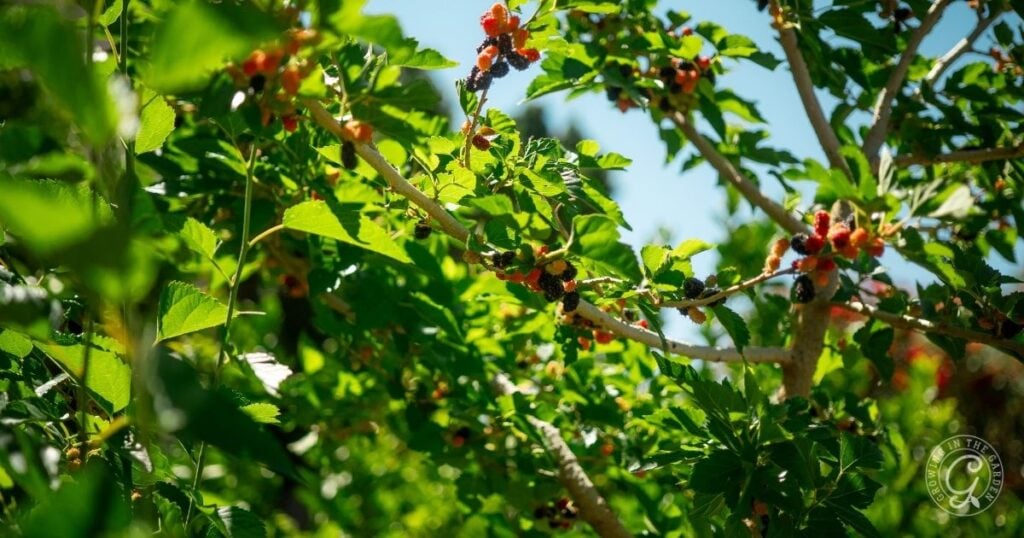
How to Grow Mulberries in Arizona:
Mulberries are fast-growing, low-maintenance trees that thrive in the heat and alkaline soils of the low desert. Once established, they’re drought-tolerant and produce abundantly with minimal care.
Varieties of mulberries that grow well in Arizona:
- Pakistan Mulberry – Large, sweet, seedless fruit with a long harvest season.
- Black Mulberry – Smaller tree with rich, flavorful fruit.
- White Mulberry (Morus alba) – Less popular for fruit, but very heat-hardy.
- Persian and Shangri-La are also good options.
Best time to plant mulberries in Arizona:
Fall or spring, once the risk of frost has passed or before summer heat sets in.
Months to harvest:
April to June, depending on the variety and weather conditions.
Tips for growing mulberries in Arizona:
- Hardy in USDA Zones 7–10; well suited for the low desert.
- Full sun is best for maximum fruit production.
- Mulberries rarely need fertilizing once established—too much nitrogen can reduce fruiting.
- Prune in late winter to shape and control size; they can grow large quickly.
- Birds love the fruit—consider netting or only planting where fallen fruit won’t be an issue.
- Most varieties are self-fruitful (no second tree needed for pollination).
Olive
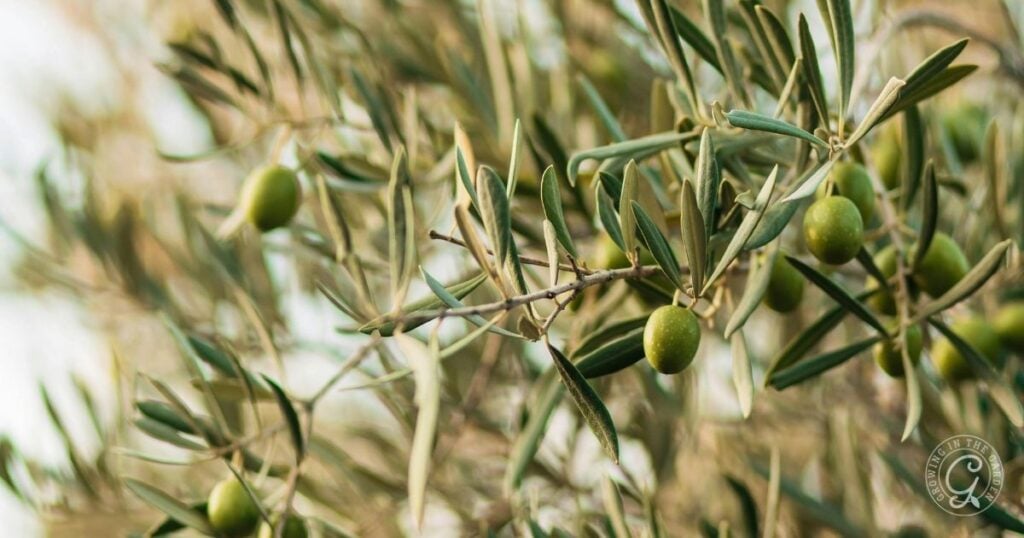
How to Grow Olives in Arizona:
Olives thrive in the low desert’s dry heat and alkaline soil. These evergreen trees are ornamental and drought-tolerant, producing fruit that must be cured before eating.
Varieties that grow well in Arizona:
- Arbequina, Arbosana, Koroneiki, and Mission are popular choices
- Choose self-fruitful or pair compatible varieties for best yields
Best time to plant:
Fall or early spring
Months to harvest:
September to November, depending on variety
Tips:
- Fruit drop can stain pavement—plant carefully.
- Full sun, excellent drainage, and minimal water once established.
- Prune to maintain size and improve airflow.
Passionfruit

How to Grow Passionfruit in Arizona:
This tropical vine produces fragrant flowers and sweet-tart fruit. It grows vigorously in warm weather and benefits from afternoon shade and consistent moisture.
Edible fruit varieties that grow well in Arizona:
- Frederick and other purple passionfruit (Passiflora edulis) are best suited
Best time to plant:
Spring, after the danger of frost
Months to harvest:
Late summer into fall, often beginning the second year
Tips:
- Pollination may improve with multiple vines.
- Needs a strong trellis or fence to climb.
- Protect from frost and scorching sun while young.
Read this article for more information about how to grow passion flower vine.
Peach
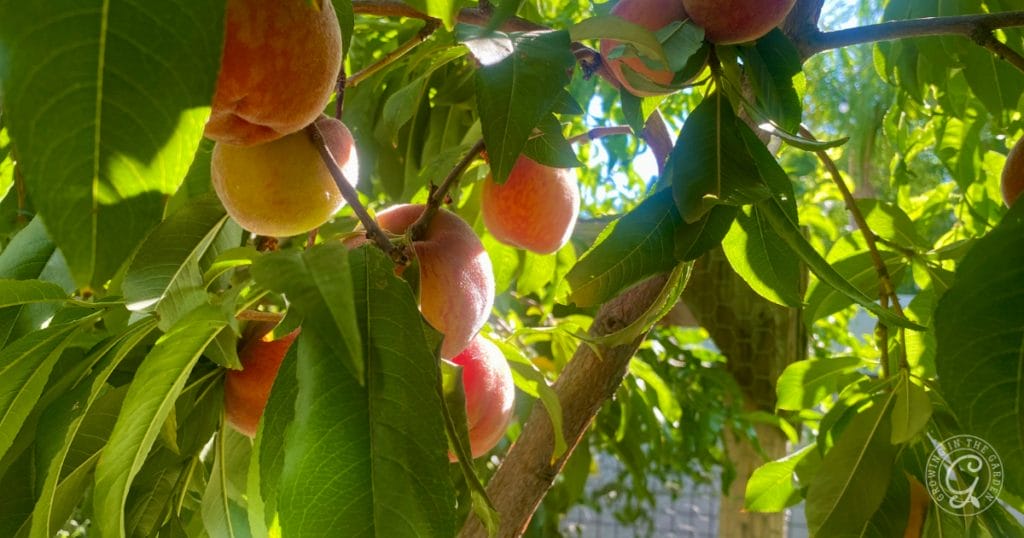
How to Grow Peach Trees in Arizona:
Peaches grow very well in Arizona when low-chill varieties are selected. Prune annually and thin fruit to prevent branch breakage and improve size and flavor.
Varieties of peach trees that grow well in Arizona:
- Bonanza Miniature – freestone, self-fruitful (250 hours or less)
- August Pride – freestone, self-fruitful (300 hours or less)
- Babcock – freestone, self-fruitful (250-300 hours)
- Desert Gold – clingstone, self-fruitful (250 hours)
- Desert Red – clingstone, self-fruitful (275 hours)
- Earligrande – semi-freestone, self-fruitful (275 hours)
- Eva’s Pride – freestone, self-fruitful (100-200 hours)
- Florida Prince – semi-freestone, self-fruitful (150 hours)
- Floridagrande – semi-freestone (less than 100 hours)
- May Pride – freestone, self-fruitful (175-200 hours)
- Mid-Pride – freestone, self-fruitful (250 hours)
- Tropic Beauty – freestone, self-fruitful (100-200 hours)
- Tropic Snow – freestone, self-fruitful (175-200 hours)
- Vallegrande – semi-freestone, self-fruitful (250 hours)
- Tropic Sweet – freestone, self-fruitful (100-200 hours)
The best time to plant peach trees in Arizona: Fall or spring when planted from container plants. Bare-root trees should be planted in January or early February.
Harvest months: April through August, depending on the variety.
Tips for growing peach trees in Arizona:
- Prune before bud break in January.
- Fertilize after the blossoms finish.
- Thin peaches to 4-6 inches apart as soon as possible after fruit set.
Read this article for more information about how to grow peaches.
Pear

How to Grow Pears in Arizona:
Certain varieties of pear do well in the low desert with proper chill hours. Like apples, they benefit from regular pruning and thinning to improve fruit quality.
Varieties of pears that grow well in Arizona:
- Floridahome – partly self-fruitful (400 hours)
- Keiffer – self-fruitful; best for cooking (350 hours)
Best time to plant pear trees in Arizona: Fall or spring; when planted from container plants. Bare root trees should be planted in January or early February.
Months to harvest: April – August
Tips for growing pear trees in Arizona:
- Fertilize and prune before bud break.
- Thin pears to at least 4 inches apart as soon as possible after fruit set.
- Fertilize monthly during growing season.
Persimmon

How to Grow Persimmons in Arizona:
Persimmons are beautiful, low-maintenance trees that ripen in the fall. Look for non-astringent varieties like ‘Fuyu’ for sweet, crisp fruit right off the tree.
Varieties of persimmon that grow well in Arizona:
- Fuyu – self-fruitful (200 hours)
- Giant Fuyu – self-fruitful (200 hours)
- Izu – smaller tree; self-fruitful (100 hours)
Best time to plant in Arizona: Fall or spring; when planted from container plants. Bare root trees should be planted in January or early February. Persimmon can be more difficult to grow from bare root.
Months to harvest: Late fall
Tips for growing in Arizona:
- Trees may take 7 years to bear fruit.
- Harvest fruit while firm; will soften indoors.
- Prune little, if at all.
- Does not need fertilizer.
- Thin heavy crops.
- Tolerates temperatures to 10°F.
Arizona Fruit Planting Guide: A Visual Guide for Low Desert Fruit
Pineapple Guava

How to Grow Pineapple Guavas in Arizona:
Pineapple guava is a frost-tolerant evergreen shrub that produces fragrant flowers and sweet, tropical-flavored fruit. It benefits from afternoon shade in hotter areas.
Varieties of pineapple guava that grow well in Arizona:
- Apollo – large fruit; self-fruitful (200–300 hours)
- Coolidge – reliable producer; self-fruitful (100–200 hours)
- Nazemetz – compact; self-fruitful (200–300 hours)
- Pineapple Gem – small tree; self-fruitful (200 hours)
Best time to plant in Arizona: Spring and fall
Months to harvest: Between September and January, depending on variety.
Tips for growing in Arizona:
- Large shrub or small tree, up to 15 feet tall.
- Grows well in containers.
- Drought tolerant.
- Evergreen shrub.
- Prune only lightly as needed after fruiting.
Plum

How to Grow Plums in Arizona:
Plums need careful variety selection and pruning to perform well in the low desert. Many Japanese types do best, and some need a pollinator for good fruit set.
Varieties of plums that grow well in Arizona:
- Beauty – self-fruitful (250 hours)
- Gulf Gold – self-fruitful (250 hours)
- Gulf Ruby – self-fruitful (250 hours)
- Methley – self-fruitful (250 hours)
- Santa Rosa – self-fruitful (300 hours)
Best time to plant plum trees in Arizona: Fall or spring; when planted from container plants. Bare root trees should be planted in January or early February.
Months to harvest: May – June
Tips for growing plum trees in Arizona:
- Fertilize and prune before bud break in January.
- Fertilize monthly during growing season.
- Thin plums to at least 2 inches apart as soon as possible after fruit set.
- Water trees well until established.
Pomegranate

How to Grow Pomegranates in Arizona:
Pomegranates are desert superstars—beautiful, drought-tolerant, and productive. Their tart-sweet fruit ripens in late summer to early fall.
Varieties of pomegranates that grow well in Arizona:
- Balegal – large fruits with pale pink skin; sweet flavored flesh; hardy to zone 7.
- Crab – medium to large fruit with bronze skin; tart but rich flavor; productive.
- Early Wonderful – large fruits with thin red skin; tart flavor; very productive.
- Granada – medium fruit with crimson skin; semi-sweet; matures early; hardy to zone 7.
- Sweet – medium fruit with pink skin; green skin with red flush; very sweet; productive; bears at a young age.
- Utah Sweet – medium-sized fruit with pink skin; sweet flavor and soft seeds; pink flowers.
- Wonderful – large fruits with red skin; tangy, flavorful, soft seeds; large red flowers; productive. This variety grows well in the low desert of Arizona.
Best time to plant pomegranate trees in Arizona: Spring and fall
Months to harvest: October – December
Tips for growing pomegranates in Arizona:
- Give pomegranates plenty of sun.
- Feed pomegranates with a layer of compost in the spring.
- Prune lightly throughout the year as needed.
Read this article for more information about how to grow pomegranates.
Strawberry
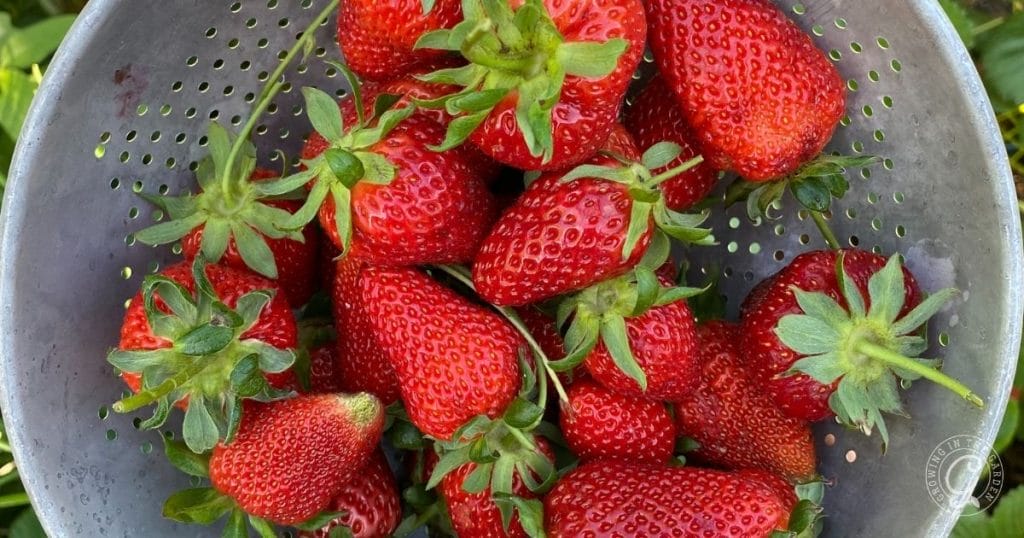
How to Grow Strawberries in Arizona:
Strawberries are best grown as a cool-season crop in Arizona. Plant in fall for spring harvests and provide afternoon shade as temperatures rise.
Varieties of strawberries that grow well in Arizona:
- Camarosa – firm, flavorful; early producer; heat-tolerant
- Chandler – juicy, sweet; high yields; best in mild winters
- Sequoia – rich flavor; good for home gardens; everbearing in warm climates
- Tioga – large fruit; productive; good for fresh eating and freezing
Best time to plant strawberry transplants in Arizona: September 15 – January
Months to harvest: April – June
Tips for growing strawberries in Arizona:
- You may need to plant new plants each year. Arizona summers are very hard on strawberry plants.
- Strawberries in Arizona need afternoon shade.
Read this article for more information about how to grow strawberries.
Additional Planting Guides for the Low Desert of Arizona
Explore these specialized planting guides, each created to help you grow successfully in Arizona’s unique climate:
- Vegetable Planting Guide – Visual planting advice for growing vegetables in the low desert.
- Herb Planting Guide – Learn the best times to plant, grow, and harvest a wide variety of culinary and medicinal herbs.
- Flower Planting Guide – Planting windows and tips for cut flowers, pollinators, and wildflowers that thrive in desert gardens.
- Vine Planting Guide – Guidance on when and how to plant climbing vegetables, flowering vines, and heat-tolerant climbers.
Was this guide helpful? Share it with a friend or fellow Arizona gardener! Helping more people grow delicious fruit in the low desert makes all the effort worth it.
The post Arizona Fruit Planting Guide: A Visual Guide for Low Desert Fruit appeared first on Growing In The Garden.